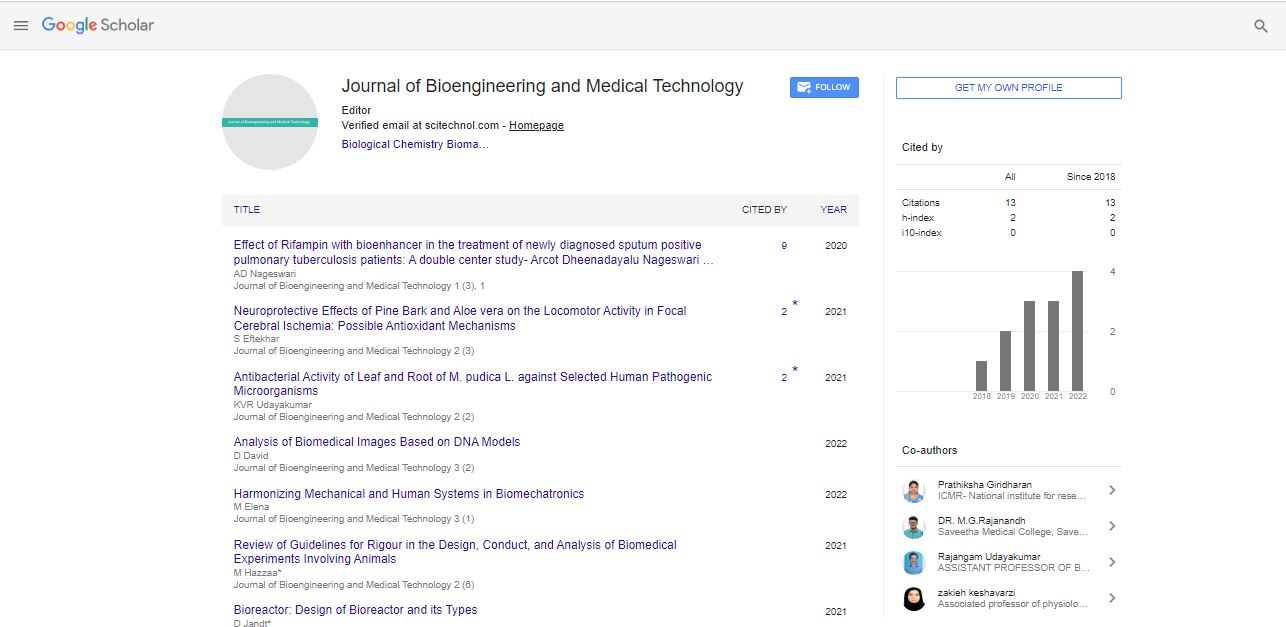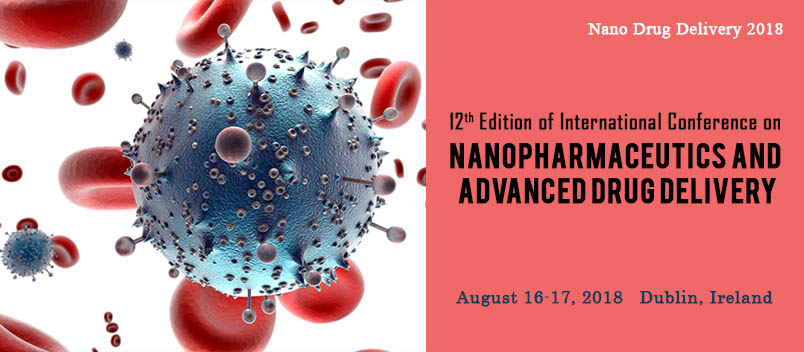Opinion Article, J Bioeng Med Technol Vol: 3 Issue: 2
Analysis of Biomedical Images Based on DNA Models
Djurado David*
Department of Pharmaceutical Technology, School of Pharmacy, Gondar, Ethiopia
*Corresponding Author:Djurado David
Department of Pharmaceutical Technology, School of Pharmacy, Gondar, Ethiopia
Email: Djuradodavid@gmail.com
Received date: 01 March, 2022; Manuscript No. JBMT-22-57158;
Editor assigned date: 03 March, 2022; PreQC No. JBMT-22-57158(PQ);
Reviewed date: 14 March, 2022; QC No JBMT-22-57158;
Revised date: 24 March, 2022; Manuscript No. JBMT-22-57158(R);
Published date: 31 March, 2022; DOI: 10.4172/jbmt.100052.
Citation: David D (2022) Analysis of Biomedical Images Based on DNA Models. J Bioeng Med Technol 3:2.
Keywords: Biomedical Images
Introduction
Inverse engineering, artificial intelligence, pattern matching, machine vision, and biomedical image analysis all have image matching as a research topic. These methods can recognize picture differences in a variety of photos. In the biomedical realm, the capacity to match an anatomical atlas, which depicts the structure of the human brain, to individual patient images is the foundation for resolving a number of critical challenges in medical image interpretation. Medical image matching algorithms have been the subject of extensive research for several years. Depending on how the photos are analyzed, the approaches may be divided into various main categories. Many biomedical photos, he asserted, have the quality that their objects and subjects are highly predictable. He looked on several methods for establishing and verifying correspondences between "seen" entities and model objects that could be beneficial in diagnosis. The letter was written in 1988. Yamada used a model-based dynamic programming matching method to extract the best-fitting shape from each static frame in a series of echocardiograms, while allowing for some variation in the length of each side of the model polygon. For dynamic imaging, this model was used. Chu is also working on a knowledge-based strategy to retrieving medical images by feature and content using spatial and temporal variables. For delivering features and contents, Type Abstraction Hierarchy (TAH) and high-level nodes models are used in this method to extract features and content. A database stores the features and content.
The Type Abstraction Hierarchy (TAH) data structure is a good way to arrange data and knowledge for cooperative query processing. It is proposed that a knowledge-based retrieval medical image model be used to show the various features and content of a picture using spatial and temporal components. Depending on your knowledge of image features, you can use default parameter values to specify query conditions. Some researchers, such as Williams, Wilson, and Hancock, have approached the image matching problem in a Bayesian framework, believing that Bayesian methodology simplifies the creation of a principled matching model. They employed Attributed Relational Graphs (ARG) to compare distinct items using graph matching techniques to determine similarity metrics. According to quantitative testing showed that their dual modal ARG enabled content-based image retrieval systems in dual-modality PET/CT. Horst, on the other hand, says that we can't always assume a perfect match between the input and one of the graphs in the database in realworld applications. As a result, an algorithm for error-tolerant matching, or, to put it another way, a mechanism for computing a measure of similarity between two graphs, is required. The role of Texture Analysis (TA) of magnetic resonance images in detecting small variations between the hemispheres in various brain areas in individuals with early indications of Parkinsonism was investigated in 2011. They used a Co-occurrence matrix-based texture analysis to detect texture differences across the hemispheres and clinically relevant areas of the brain.
The Mann-Whitney U test was used to assess the results of the texture analysis. Understanding the nature of various types of matrices was an issue with co-occurrence matrices approaches. Several problems involving several mathematical procedures are presented by Leydesdorff and Vaughan. Wang recently developed a new way to fix mild asymmetry utilizing a computer-aided design process in 2012. The Medpor implants in the body are shown using surface rendering technology following surgery in this way. Surface rendering is gathering data on a body in order to build a three-dimensional representation of that body. The matching technique is used to evaluate the procedure after it has been used. Several point correspondence medical picture matching systems were tested in this research study, each with its unique set of traits, strengths, and drawbacks. The fundamental issue and disadvantage of the above techniques is their sensitivity to data loss, which is useless for medical applications, as well as their neuroimaging element. To address these issues, we have proposed a revolutionary medical image matching method. The method is based on the statistical analysis of digital photographs that have been DNA Modeled.
DNA Modeling
DNA is a deformable and flexible polymer whose equilibrium structure and flexibility are substantially influenced by its sequence. DNA's conformational flexibility is required not just for adaptation when it interacts with DNA-binding proteins, but also for dense DNA packing, which can include severe bending, twisting, and stretching of DNA in folded chromatin segments. To comprehend how proteins detect specific DNA segments during gene regulation, packing, and repair, it's critical to understand how DNA structure and flexibility are sequence dependent. A coarse-grained model of DNA's helical structure is typically used, with the nucleobases represented as rigid planes and the translational and rotational parameters acquired through rigid-body transformation. The structure of an N-base-pair-long DNA molecule is determined using 12N–6N helical parameters in this technique. Furthermore, using such a coarse-grained model, not only the structure, but also the flexibility of DNA has been investigated. To date, a harmonic stiffness model has been widely used to describe the sequence-dependent flexibility of DNA. An effective stiffness matrix for the DNA molecule in terms of the helical parameters provides the force constants for the quadratic model. Importantly, the Harmonic Model (HM) implies uni-modal behavior, which means that the variation of all parameters in the quadratic potential follows a single Gaussian distribution. However, a comparison of helical parameter distributions from atomistic Molecular Dynamics (MD) simulations with actual structures indicated that numerous parameters are multimodal.
Previous research has revealed that a polymorphism in the backbone structure causes multimodal variation (the combination of Gaussians). The BI and BII conformations, which are the result of concerted rearrangements in the backbone dihedral angles and whose population is known to be extremely sequence-dependent, are the most prominent backbone substrates. The local conversation of conformational variations is another important property of DNA flexibility: Within a tetra nucleotide sequence, a given base-pair step is related to its nearest neighbor basepair step, but not much beyond that. Physically, this is explained by the fact that in double-stranded DNA, stacking interactions only allow a base pair to connect with its neighboring base pair, not with distant base pairs (in contrast to folded proteins or RNA). It can also be seen in a B-sparse DNA's stiffness matrix, where diagonal and nearestneighbor stiffness terms dominate. As a result, using the local stiffness information of short DNA fragments to describe the complete DNA is an appealing approach for creating a coarse-grained description for the deformability of a DNA duplex of any length. However, as previously stated, an appropriate description should take into account both properties of nearest-neighbor coupling and multimodality. A huge number of potential combinations of backbone substrates along DNA produce multimodality, and each combination necessitates a distinct stiffness matrix. Only one of the two contributions to DNA flexibility is currently accounted for in current models. Incorporating both effects, on the other hand, is difficult and has yet to be accomplished, as it necessitates covering the coupling of every local sub state to all nearest-neighbor substrates. In general, coarsegrained models have used a basic, additive, and harmonic Hamiltonian to simulate DNA deformability. Typically, the model's parameters are derived via systematic MD simulations or experimental structures. To compute the deformability/flexibility of arbitrary DNA sequences, web servers such as DNA and the cgDNA model are available.
These models capture local conversations, but they don't account for multimodality coarse-grained model in conjunction with a Monte Carlo technique in a recent study. This method allows for the creation of multimodal probability distributions from ensembles of structures. However, the model overlooks certain crucial aspects of DNA flexibility: The deformability is characterized by a 66 stiffness matrix, which ignores nearest-neighbor harmonic coupling between consecutive base-pair steps and does not account for intra-base-pair parameter changes. Furthermore, the BI and BII substates' relative frequencies are assumed to be constant (not depending on the neighboring steps). The goal of this research is to develop a conformational flexibility model for DNA that accounts for full nearest-neighbor harmonic coupling as well as multimodality due to substrates. To represent the influence of all potential sub states of a DNA, it blends the harmonic stiffness approximation inside a substrate with a using model. It takes into account both nearest-neighbor coupling and multimodality at the same time, as well as all intra and inter-base-pair factors. A base-pair step is discretized in this approach to be either in the BI or BII state, and each of these states is described by a matching HM. Our coarse-grained model is specified at the tetra nucleotide level, allowing us to accurately capture couplings between adjacent BI/BII states throughout a DNA strand.
 Spanish
Spanish  Chinese
Chinese  Russian
Russian  German
German  French
French  Japanese
Japanese  Portuguese
Portuguese  Hindi
Hindi 
